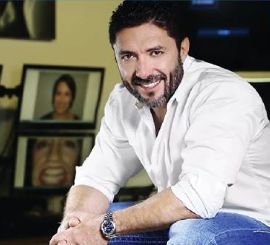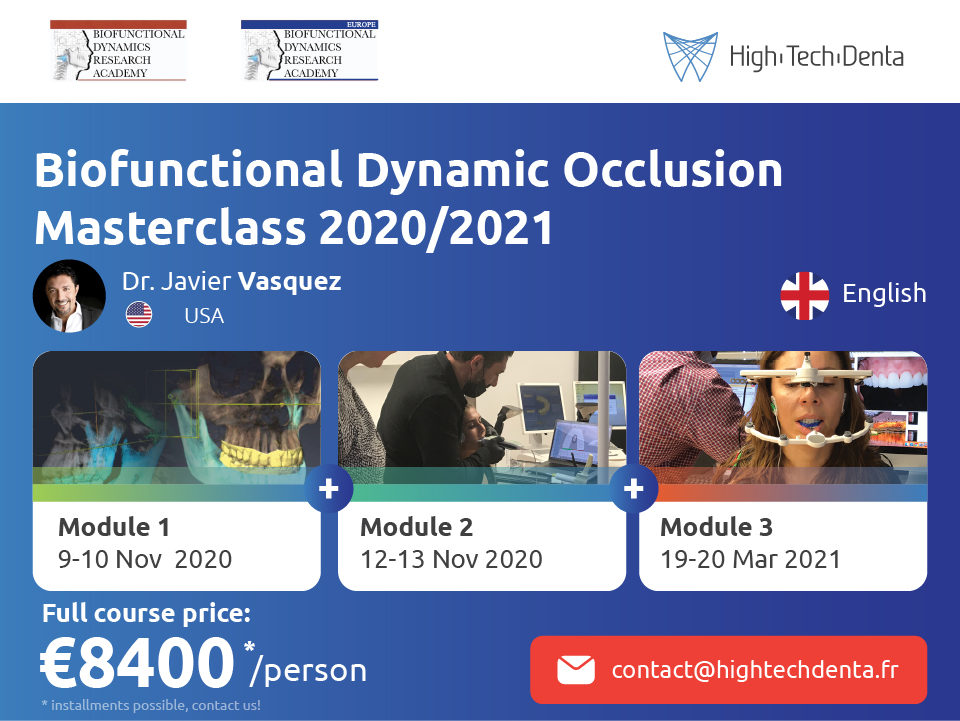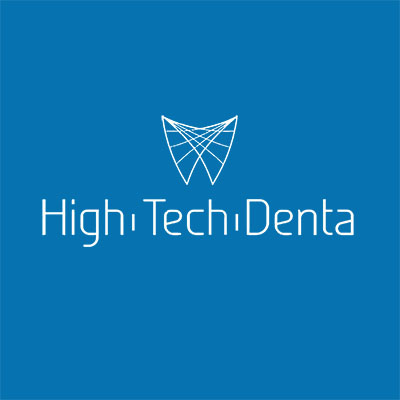9-10 Nov 2020 Module 1 – Introduction to the Concept: Biofunctional Dynamic Occlusion – Level 1
12-13 Nov 2020 Module 2 – Biofunctional Mandibular Dynamics – Level 2
19-20 Mar 2021 Module 3 – Digital Functional Esthetics – Level 3
Price full course 8400 Euro*
*installments possible – click here for details
Introduction to the Concept: Biofunctional Dynamic Occlusion – Level 1
For years the human being has being trying to make the analysis of the function based on artificial movements or under the influence of manipulation to force and believe in a hinge axis rotation.
The real organic movements is a compensatory reaction between the glenoid fossa and the eminence into the condyle as a result of the dynamics of the cervical spine and not only the condyle as a unique mobile component into the functional system. After hundreds of cases of kinematic studies utilizing advanced jaw trackers that allowed to visualize the CBCT’s in motion , we can see that many of these concepts that became dogmas are unique movements for each individual. The concept of Biofunctional Dynamics are a combination of the concepts of Professor Dr. Mariano Rocabado law of the 50-50 in conjunction with physiological concepts of muscle balance, joint decompression and occlusal stability.
This part of the lecture will also cover the different factors that influence mandibular trajectories taking as a consideration internal joint deraignment, postural problems, muscle disharmony , facial asymmetries, and occlusal interferences.
DAY 1 / 9 Nov
Analysis of the body as an entire unit
Postural compensations
Records for full body analysis
- Specificitybof the movement of the cranial cervical structures
- The law of 50-50
- Defining normality in static position and dynamic movements
- Action reaction law
- Rocabado lateral and AP cephalometric analysis
- Cráneo cervical assessment by palpation
- Correlations between similar assessment with pictures with 2d X-rays
- Defining ideal posture kyphosis lordosis
- Understanding head forward posture and the variables and implications
- Static atlas syndrome and implications
- Anatomical variables : Ponticus posticus
- Influence of posture in cephaleas
- Vascular headaches and neuropathies
Mandíbular trajectories
Muscular component
- Factors that affect mandíbular trajectories
- Muscles basic vector direction and functions
- Muscle function in the stomatognathix system
- Influence of muscles in mandíbular trajectories
Arthrokinematics of the sinovial compartment
- Understanding kinematics and ostheokinematics
- Main components of the temporo mandíbular joints
- Pain mapping
- Difference between chronic and acute disorders and the influence in mandíbular movements.
- Clinical assessment of the temporomandibualr joint
- Visual analysis of the movement
- Clinical history
/ HANDS ON
- TENS bite
- Students must have a set of models of themselves Material needed for bite registration practice
- Occlusal tables
- Analysis of the occlusal plane
- Clinical and applications
- Tricks and pearls
DAY 2 / 10 Nov
Facial asymmetries
- Facial asymmetries of craniocervicalnorigin – Understanding the influence of cervical structures in mandíbular movement
- Real facial asymmetries
- Triplanearvanalysis
Introduction of the craneodontics concept
- Influence of dental interference in manibular movements
- Influence of proprioception and ostheoception
Implementation of instrumentation
- Understanding muscles fighting sequence
- Muscle interpretation to determine mandíbular position
- Physiology of the muscles
- Introduction to electromyography
- Muscle fatigue
- Muscle torque
- Insufficient occlusion
Implementation of instrumentation
- Centric relation
- Habitual occlusion
- Neuromuscular trajectory
- Optimized trajectory
- Phonetics
- Swallowing patterns
/ HANDS ON
- Analysis of a tridimensional CBCT
- Structural Analysis
- Joint position
- Joint integrity
- Airway
- Integration of function
- Clinical protocols
- Introduction to SICaT function and JMT demonstration
Partners:
Select your ticket type below
* Payment by bank transfer or check, High Tech Denta SAS
Contact us: contact@hightechdenta.fr
High Tech Denta SAS
8F Rue Jeanne Barret
Parc Valmy
21000 Dijon
IBAN. FR76 1080 7004 4892 4211 6290 735
BIC. CCBPFRPPDJN
Banque Populaire agence Valmy
SHARE WITH FRIENDS:

Dr. Javier Vasquez – DDS
Doctor





